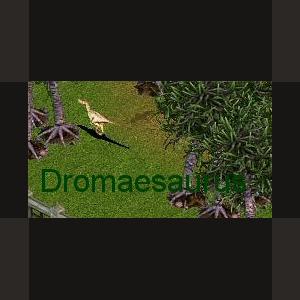About This File
The first known Dromaeosaurus remains were first discovered by paleontologist Barnum Brown during a 1914 expedition to the Judith River Formation on behalf of the American Museum of Natural history. The area where these bones were collected is now part of Dinosaur Provincial Park in Alberta, Canada. The find consisted of a partial skull 9 inches in length and some foot bones. Several other bones, and dozens of isolated teeth, are also known from subsequent discoveries in Alberta and the western United States.[1]
Several species of Dromaeosaurus have been described, but Dromaeosaurus albertensis is the most complete specimen. Additionally, it is apparent that this genus is even rarer than other small theropods, although it was one of the first small theropods described based on reasonably good cranial material.
In 1969 similarities in anatomy between Dromaeosaurus and its relative Deinonychus were first observed. Based on the sickle-claws and commonalities in the skull, a new family, the dromaeosauridae was erected to house these two genera.[1] Since then, many new relatives of Dromaeosaurus have been found.
Dromaeosaurus differs from most other Dromaeosauridae in having a short, massive skull, a deep mandible, and robust teeth. In these respects Dromaeosaurus resembled the tyrannosaurs. The teeth tend to be more heavily worn than those of its relative Saurornitholestes, suggesting that its jaws were used for crushing and tearing rather than simply slicing through flesh.
It is possible that Dromaeosaurus was more of a scavenger than other small theropods, or it may be that Dromaeosaurus relied more heavily on its jaws to dispatch its prey. It was probably better suited to tackling large prey than the more lightly built Saurornitholestes.
The relationships of Dromaeosaurus are unclear. Although its rugged build gives it a primitive appearance, it was actually a very specialized animal. It is usually given its own subfamily, the Dromaeosaurinae; this group is thought to include Utahraptor, Achillobator, Adasaurus and perhaps Deinonychus.
However, the relationships of dromaeosaurs are still in a state of flux. "Dromaeosaurus Morphotype A" is the designation given to a series of unusual, ridged dromaeosaur teeth from Alberta. These teeth probably do not belong to Dromaeosaurus, although it is unclear from what animal they do come.



Recommended Comments
There are no comments to display.
Create an account or sign in to comment
You need to be a member in order to leave a comment
Create an account
Sign up for a new account in our community. It's easy!
Register a new accountSign in
Already have an account? Sign in here.
Sign In Now